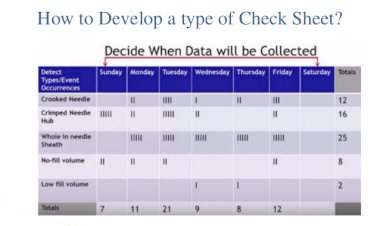ISO 13053 Measures of Six Sigma
iso-13053-measures-of-six-sigma

The different measures are used in six sigma project, depends on project to project, i.e. DPMO , DPO , Z Score. These are the metrics for measures.
ISO 13053 Measures of Six Sigma
In a Six Sigma project, measures are used to judge the performance of a process as this provides a basis for the improvements that can be attained in business processes through Six Sigma projects. ISO 13053 Measures of Six Sigma is a robust standard specifically designed for Six Sigma. In the initial stages, the measures help in quantifying the problem being faced in the process. Similarly, when the project is nearing completion, these measures help in validating the improvement in the process. There are various measures that are used in Six Sigma projects and vary from project to project.
1) DPO – It is the short form of Defects per Opportunities. In this method, total defects are divided by the Number of Samples checked multiplied by the Total Number of Opportunities. Opportunities are potential chances of committing a defect. For eg. If a product is being checked for 10 features, then there are 10 opportunities for committing a defect in that product.
DPO = Total Defects
_______________________________________________
Total Samples Checked * Total Number of Opportunities
2) DPMO – It is the short form of Defects per Million Opportunities. In this method, DPO is calculated by 1 million to know how much defects are there for a million opportunities. DPMO has emerged as the primary measurement criteria for validating a process performance, with 3.4 defects per million opportunities being the criteria for attaining Six Sigma level performance.
DPMO = DPO * 1,000,000
3) Sigma score – This is derived from the normal distribution, with a 1.5 sigma shift happening between the short-term and long-term variation present in the process. As it is known, 1.5 sigma is added to the long term sigma level to get the short term sigma level.
4) RTY – It is the short form of Rolled Throughput Yield. It is the combined quality of all the processes involved in the making of a product or service. In an organization, a product is generally a result of a number of processes, with one process output acting as an input for another process. If any of the process is not performing as desired, then it will impact the final 0utput also. For eg. A product is being made with 3 sequential processes, with all of them acting as an input for another process down the line and all giving 80% quality. This means that quality of the final product will be just 51.2%.
RTY = Process 1 * Process 2 * Process 3
= 80% * 80% * 80% = 51.2%
5) RR – It is the short form of Return rate. It means the number of returns in a specified period. Returns can be both real and requests for returns.
6) NPR – NPR or Number of Problem Reports means the problem reports generated by customers regarding the quality of a product, within a specified period. Such reports are sometimes further categorized into different groups such as critical, major and minor based on the criticality of the problem reported.
7) OTD – OTD or On Time Delivery is defined as delivery to customers on the committed time. It is generally measured in percentage terms to know the proportion of deliveries made to customers on time.
8) COPQ – COPQ or Cost of Poor Quality is defined as costs incurred by the company for producing and correcting defects, both due to internal factors and external factors. It also includes the costs related to repairing or replacing the defective products at customer end and finding out root causes for the defects. COPQ comprises a large part of the Cost of Quality (COQ) spent by the company.

 Artees Gupta
Artees Gupta 




























Comments (0)
Facebook Comments